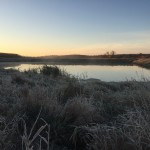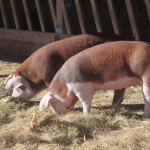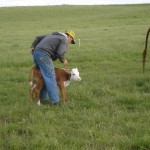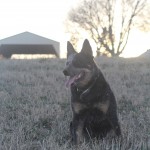 Our farming philosophy is essentially a long term goal for our farming operation. We feel for our current farming operation the four most important goals are Sustainability, Conservation, Diversification, and Education.
Our farming philosophy is essentially a long term goal for our farming operation. We feel for our current farming operation the four most important goals are Sustainability, Conservation, Diversification, and Education.
These are ideals that have been handed down to Jake from previous generations and were important aspects of his farming life while growing up on the farm. They are now things we would like to carry on in our farming operation.
 We feel the number one goal of our farm is to be environmentally and economically sustainable. Maintaining an environmental equilibrium of inputs and outputs on our farm (i.e., a farm eco-system) is a life time duty bestowed upon us by being land and livestock owners. Jake was always taught growing up to put back what you take off and leave it in better shape than when you got it.
We feel the number one goal of our farm is to be environmentally and economically sustainable. Maintaining an environmental equilibrium of inputs and outputs on our farm (i.e., a farm eco-system) is a life time duty bestowed upon us by being land and livestock owners. Jake was always taught growing up to put back what you take off and leave it in better shape than when you got it.
If we take care of the land and livestock the land and livestock will take care of us, which in turn, will provide economic sustainability. Economic sustainability is achieved over the long term. There will be bad years, there will be good years, and there will always be stressful money decisions to be made, but over the life time of our farm we want to be able to live a simple, moderate, and humble lifestyle
 Conservation and sustainability go hand in hand. You cannot be sustainable without preventing damage or loss to your land or livestock. Jake’s father placed a high emphasis on soil conservation while he was growing up which has heavily influenced our farming techniques. Nearly 100% of our row crop acres are No-till and planted on contour when necessary. The tillage we do use is for establishing new seeding, tilling in manure, or maintaining water shed structures.
Conservation and sustainability go hand in hand. You cannot be sustainable without preventing damage or loss to your land or livestock. Jake’s father placed a high emphasis on soil conservation while he was growing up which has heavily influenced our farming techniques. Nearly 100% of our row crop acres are No-till and planted on contour when necessary. The tillage we do use is for establishing new seeding, tilling in manure, or maintaining water shed structures.
We also utilize terraces, waterways, buffer strips, and tiling to help prevent soil erosion. It takes centuries to buildup fertile top soil, but it can be lost in a matter of one heavy rain. This makes it very important for us to implement conservation farming practices. Conservation is always an ongoing practice and although we do many things to help conserve the land there are many other practices we would like to implement when time and finances allow.
 To sum it up in one phrase “Never put all your eggs in one basket”. By having both row crop and livestock we help spread our risk across different commodities. The philosophy of being “to big to fail” like many of the large factory farms doesn’t suit our operation.
To sum it up in one phrase “Never put all your eggs in one basket”. By having both row crop and livestock we help spread our risk across different commodities. The philosophy of being “to big to fail” like many of the large factory farms doesn’t suit our operation.
So many things can go wrong farming (e.g., falling market prices, drought, flooding, disease, etc.), however, the hope is not all at once. Ideally, when one commodity does not generate the income required the other commodities help make up the shortfall. The introduction of the Hereford pigs to our operation will provide us one more tool for risk management.
 Educating people about where, when, and how food is grown empowers the consumer to make better decision about what they eat and generally creates a spokesperson for small family owned farms. The more people we have understanding that farmers are trying to be sustainable and trying to do the right thing for the environment the easier the small family farms can survive.
Educating people about where, when, and how food is grown empowers the consumer to make better decision about what they eat and generally creates a spokesperson for small family owned farms. The more people we have understanding that farmers are trying to be sustainable and trying to do the right thing for the environment the easier the small family farms can survive.
There is becoming a bigger disconnect between consumers and farmers of what it takes to actually grow a bushel of grain or a pound of meat. We have found the best way to make that connection is to have people visit our farm; show them our land and livestock; Explain to them the general life cycle of a grain plant or a market animal.
Ultimately, we hope the people that visit our farm will go out and tell someone else about what they learned and start a conversation about where, when, or how food is produced.